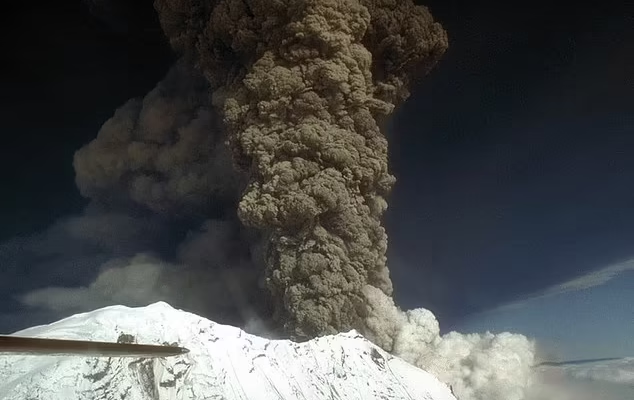Nearly 300,000 residents in Alaska’s largest city are preparing for a potential volcanic eruption.
Mount Spurr, a 11,000-foot volcano located just 81 miles from Anchorage, is expected to erupt this year for the first time in 30 years.
As a result, city officials have elevated the emergency planning level to Level 2, signaling an increased effort to communicate the threat to the public and prepare safety agencies for eruption response procedures.
“If the eruption occurs during the school day, once we get confirmation, we will immediately reach out to the Volcano Observatory,” said Jared Woody, Director of the Anchorage School District Office of Emergency Management.
“We’ll coordinate with the National Weather Service and the city to assess the situation, including whether the ash plume is heading our way.”
According to scientists at the Alaska Volcano Observatory (AVO), Mount Spurr is “moving closer to an eruption,” which could occur in the next “weeks to months.”
On March 7, the volcano began emitting elevated levels of gas from its summit and a side vent that last erupted in 1992. These emissions are part of a series of signs of increased activity at the volcano, which has been experiencing unrest since April 2024. Small earthquakes during this period marked the first indication that new magma was rising toward the volcano’s vents.

“This escalation is simply because we know the possibility of an eruption is increasing, and we’re preparing accordingly,” said Municipal Manager Becky Windt Pearson.
The eruption is expected to occur at the Crater Peak side vent, which would be explosive, according to Matt Haney, scientist-in-charge at the Alaska Volcano Observatory (AVO) at the US Geological Survey (USGS). He told DailyMail.com that the eruption could produce multiple ash plumes rising up to 50,000 feet into the air.
Each explosive episode that produces ash would likely last three to four hours, with the ash cloud potentially covering Anchorage and nearby communities in a thick layer of dust.
In addition to the ash, the eruption would likely trigger destructive mudslides and avalanches, with volcanic debris racing down the volcano’s slope at speeds over 200 miles per hour. However, Haney reassured that no communities in the direct path would be affected by this.
The USGS has issued an ‘advisory’ for the volcano, indicating it is showing signs of elevated unrest.
In response to Mount Spurr’s heightened activity, Anchorage School District officials have outlined their emergency plans. The first step will be to contact the AVO to evaluate the threat and determine how much time they have to respond.

An eruption from this massive stratovolcano could cover the city of Anchorage, home to nearly 300,000 people, in a thick layer of ash

Mount Spurr is one of 53 volcanoes in Alaska. It sits 81 miles from Anchorage
“The response time really depends on how much time we have,” said Anchorage School District Chief Operating Officer Jim Anderson.
“If they say there’s no ash heading toward Anchorage, it’s business as usual. We may pre-stage buses, but if they say it’s coming now, we will close schools and inform the public.
“As for the buses, we’ve already coordinated with transportation, and they will start getting kids home as they would at the end of a normal school day.”
However, if the ash plume arrives too quickly for schools to send kids home in time, officials have a backup plan.
“If it’s moving fast enough that we can’t get them home, we would move them to one of our shelter sites, where we have cafeterias and can feed them,” Anderson explained.
“They’ll have water, and we’ll inform the public. We know some parents will come to pick up their kids, and we’ll have staff there to ensure the link-up process goes smoothly.”
District officials emphasized that every school has a volcano response plan, which includes shelter-in-place procedures and air quality measures. Extra precautions will be taken for students and staff with respiratory conditions.
The district also has 22 emergency Connex units spread across schools, stocked with N95 masks, first-aid kits, and other essential supplies for staff, students, and visitors who may be inside when the ash cloud arrives.
According to Haney, the eruption of Mount Spurr will likely resemble the 1992 eruption.
In June of that year, the Crater Peak flank vent, which had been dormant for nearly 40 years, erupted after 10 months of heightened seismic activity, as reported by the USGS.


Mount Spurr’s summit vent has not erupted in the last 5,000 years, scientists estimate
The 1992 eruption of Mount Spurr blanketed Anchorage, home to nearly 300,000 residents, with an eighth of an inch of ash. The skies darkened in the middle of the day due to the massive cloud of dust and gas, causing the city’s airport to close for 20 hours. Crater Peak erupted two more times that year, once in August and again in September.
The Municipality of Anchorage reported nearly $2 million in damages, office closures, and cleanup costs from the August eruption, according to the National Oceanic and Atmospheric Administration (NOAA). While no one was directly killed by the eruptions, two heart attacks — one of which was fatal — were reported in Anchorage from people shoveling ash. Breathing in ash also presents health risks, as the fine particles can enter the lungs and worsen conditions like asthma or bronchitis.
For the past year, the Alaska Volcano Observatory (AVO) has been closely monitoring Mount Spurr’s increased activity. Between April 2024 and February 2025, the volcano displayed three key signs that an eruption may be imminent: increased seismic activity, swelling of its surface, and melting snow and ice near the summit.
Last month, the AVO stated that the volcano’s activity could either subside or lead to an eruption. However, on March 7, scientists conducted a flyover of Mount Spurr and detected gas emissions that were “above background” levels for the first time since the heightened activity began. Another flyover on March 11 confirmed that the volcano was producing unusually high gas levels.
“Based on the new gas emissions above background, we concluded that an eruption, similar to the two recent ones, is the most likely scenario,” said Matt Haney, scientist-in-charge at the Alaska Volcano Observatory.
Mount Spurr last erupted in 1992 and again in 1953, both times from the Crater Peak side vent. Haney and his team estimate that the summit crater of the volcano hasn’t erupted in the last 5,000 years. When Mount Spurr does erupt again, it is expected to come from the side vent.
While all signs point to an imminent eruption, the exact timing remains uncertain. According to Haney, if activity continues to escalate, the next sign of an eruption will likely be a volcanic tremor.
This would differ from the brief, shallow earthquakes that Mount Spurr has already been experiencing.
A volcanic tremor is a sustained period of shaking that can last anywhere from minutes to days. It occurs when magma beneath the volcano starts rising toward the surface, signaling that an eruption is drawing closer.
In 1992, Mount Spurr experienced a volcanic tremor about three weeks before the eruption in June, meaning that this type of seismic activity could suggest that the volcano might erupt in just a few weeks. However, other volcanoes, like nearby Mount Redoubt, have shown longer intervals between a volcanic tremor and an eruption. For instance, Mount Redoubt experienced tremors for two months before it erupted in 2009.
Though predicting the exact timing of an eruption is uncertain, Haney and his team will continue to monitor Mount Spurr closely to better estimate when an eruption is most likely to occur.



